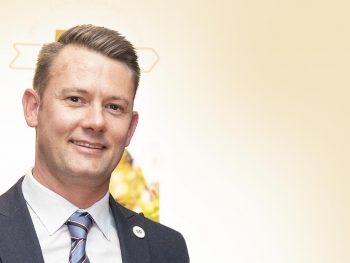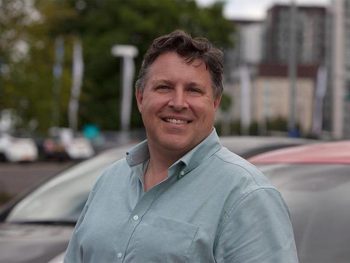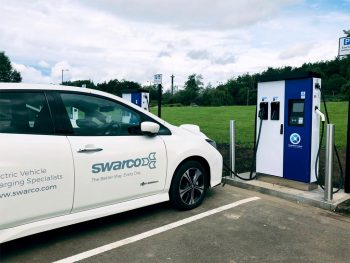Interview: Swarco Smart Charging on tackling Scotland’s EV charging
Justin Meyer, managing director of Swarco Smart Charging, talks of the challenges ahead as the country aims for zero emission transportation. Norrie Hunter reports.

Justin Meyer, managing director of Swarco Smart Charging
One of the biggest challenges in Scotland’s transition to net zero emissions and widespread adoption of electric vehicle transportation has been the introduction and delivery of a country-wide EV charge point network – one capable of meeting the demands of an ever-growing number of drivers making the switch. The rapid growth on EV ownership in the last two years has been astounding and has concentrated minds on how the country’s charging infrastructure will cope with demand.
A decade ago, the Scottish government recognised that a massive change was happening but perhaps unaware of the speed of that progression, especially in the rapid uptake of EVs in both public and private sectors over the last two years.
ChargePlace Scotland (CPS) was established by the Scottish government at a cost of £45m. CPS didn’t own any charge points but provided the operational system that connects the chargers into a network, interacting with customers from billing through support provision.
Problems began developing in the CPS back-office systems which handled all calls, emails and online fault reports. Transport Scotland decided to award this service, for an initial two-year period, to Austrian traffic tech company Swarco Smart Charging… it went live on 27 July last year. There were initial difficulties with account transfer and registration and with the new CPS app. which saw major changes required to system operations. It was a huge challenge and one which would define the future direction and success of Scotland’s charge point infrastructure.
Swarco’s vast global experience in deploying major traffic and electric vehicle charging infrastructure projects enabled them to effectively plan for the biggest EV network migration seen in the industry to date. Its brief was to determine the key operational difficulties and implement an effective system capable of providing service to Scotland’s burgeoning EV marketplace.
The Electric Vehicle Association Scotland, which represents EV drivers’ interests, says it is essential to have a smooth-running public charging system that delivers a fast and efficient service for the increasing number of people making the transition to all electric transportation.

Neil Swanson, EVA Scotland director
Neil Swanson, EVA Scotland director, commented: “Having confidence in being able to access the charging network in a simple and trouble-free way is imperative.
“At the beginning of this process of providing EV charging facilities in Scotland there were some difficulties in establishing the ChargePlace Scotland network. There were few chargers and for some journeys drivers required detailed planning to ensure they could replenish their car batteries. This required lots of perseverance and drivers frequently struggled to get support from the helpline. Some of the challenges faced in rolling out new infrastructure lay in the processes, some in the power supply, some in the cellular network coverage.
“Today, the number of EVs on the roads in growing exponentially, and at EVA Scotland we expect to see continued improvements to the charging landscape.”
On the first anniversary of being awarded the contract to take full operational responsibility for Scotland’s public electric vehicle charge point operations, Justin Meyer, managing director of Swarco Smart Charging talks of the challenges ahead as the country aims for zero emission transportation.
Q1. What have been the most significant achievements / improvements you have made at Swarco Smart Charging since being awarded the contract in 2020?
JM: Prior to migration we opened a purpose-built, new office, in the at the Michelin Scotland Innovation Parc in Dundee – reflecting our commitment not only to CPS, but to the local economy, whilst actively supporting Scotland’s overall desire to achieve Net Zero.
Recruiting an initial 14 employees locally, we invested in not just training, but also in exposure to and involvement with a wide range of interested and engaged parties overall, representing all stakeholders from the driver through to the host and owner; giving our team a well-rounded understanding of just how vital this network was to so many.
By May 2022, before our first year was complete, the CPS team at MSIP had doubled in size, and this will continue, providing local opportunities for development in technical and media fields for staff.
The (charging) network is now a vastly different network to the one we inherited on 27th July 2021. We have overseen some real transformational activity and delivered continuously improving results.
The (Dundee) Service Centre at the core of the operation continues to successfully handle increasing volumes reflected by the ongoing growth in membership and network use. Recently we saw our first week of over 36,000 individual charge sessions and over 700,000kWh consumed – we passed the 45,000-member mark with now over 13,000 charge cards issued since January.
The CPS network now stands at 2,280 publicly available units at the end of May. In the first three months of 2022, 90 new public chargers went live and there is a healthy number of new chargers being planned for the future by both public and private hosts. Scotland is leading the UK in rapid charger provision per head of population, but it is not just about increasing the numbers, it is also about providing a better driver experience which is why all new rapid chargers added to the CPS network must have the capability to accept contactless payments.
We are also looking further afield demonstrated by the recent intra-operable partnership with Manchester’s Be.EV network, which means our CPS drivers can now use their membership outside of Scotland.
Overall, the general health and availability of the network has never been greater. The Service Centre fields an average of 140 fault reports a week that require a supplier engineer to attend, and more than 80% are resolved within the same week, if not within days.
We know our drivers are happy because they tell us. Not only are they completing session surveys in their thousands, but they are also taking the time to write and thank the team regularly and applauding them for their service.

The relationship between charge point manufacturers and the auto industry in developing aligned technology progress is key
Q2. The next few years will be crucial for Scotland’s public charging network. What in your view are the key challenges lying ahead?
JM: Continuing to give EV drivers and charger owners the confidence that the network will continue to be built with both groups in mind. It must continue to provide that single, unified, easy point of access; delivering confidence and reducing range anxiety for both new and experienced drivers out there.
Some serious consideration should also be given to demonstrating the improvements, and future potential, of the technology and what benefits it can provide at a commercial level for both private and local authority owners.
The relationship between charge point manufacturers and the auto industry in developing aligned technology progress is also key.
Q3. Scotland’s Transport Minister Jenny Gilruth said recently that public and private partnerships are key to meeting the charge point infrastructure required to service the rapidly growing number of EVs coming on to our roads. What is your opinion?
JM: Yes, these are key to future success. Scotland’s government has led the way in initiating a vision of a widespread public access EV network, but it is private investment that will support the ongoing growth and modernisation required to meet the demand for both volume and ease of access.
Q4. You have overcome many problems and challenges of network transition. What are the key areas still outstanding and how is all of that reflected in the most recent customer satisfaction figures?
JM: We have focused heavily on learning lessons. Importantly we listen to the drivers using the network and the concerns they raise.
Range anxiety is now less of an issue and so, through network growth and improved unit and fault performance, accurate tracking of unit performance over time and increasing options for access and payment, these are key to future success.
Overall, however we have very healthy customer satisfaction returns which have been consistent over a six month plus period. While we would never dismiss the frustrations individual drivers can experience, a consistent return of 78% overall satisfaction and a minimal 7% dis-satisfaction is an incredibly positive baseline to work from considering where we started.
Q5. In your opinion, are Scotland’s 32 Local Authorities doing enough planning and implementation to meet the surge in EV sales in Scotland?
JM: We are not involved in this area, but we do hear that many local authorities are now looking seriously into the data and performance of their own respective networks and their users to better understand what is required to meet future needs.
Q6. Over the next 12 months (up to the contract renewal period) what will be your focus?
JM: Service excellence – we’ll be improving not just drivers’ ease of access and transaction, but also our communications and feedback channels, keeping them abreast on network developments, and encouraging greater mileage and general network use.
Building relationships with all suppliers, owners, and key stakeholders, with an aim to help them seamlessly grow the network, utilising data and performance to make the best decisions for their businesses and local areas.
We will also follow through with our committed development activity on the software solution, including App so that more enhanced features and functionality is available to charge point owners and the EV driver community.












